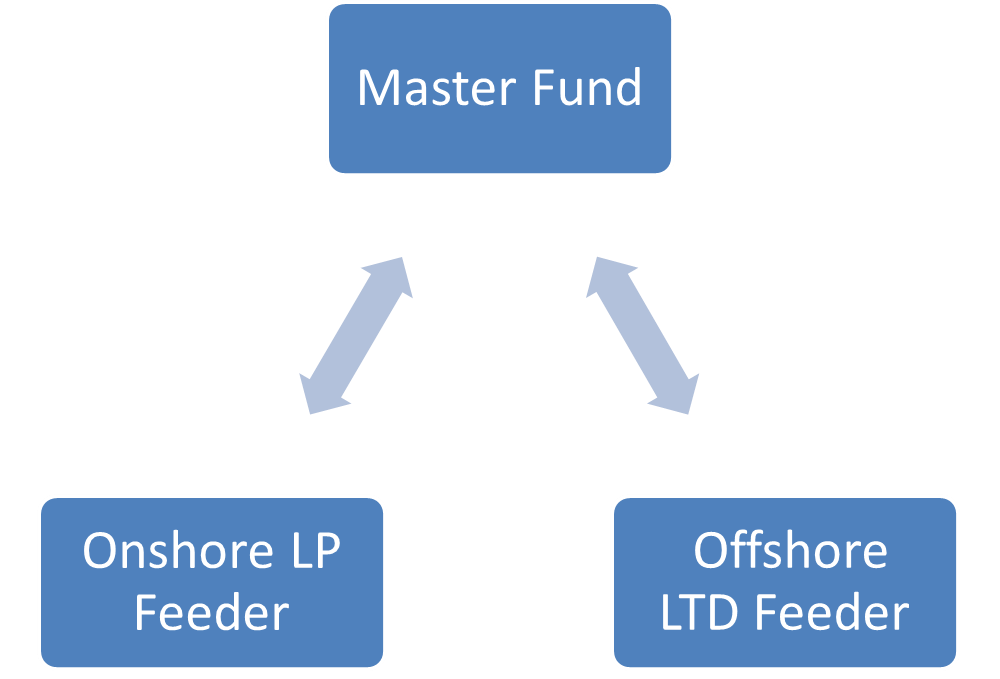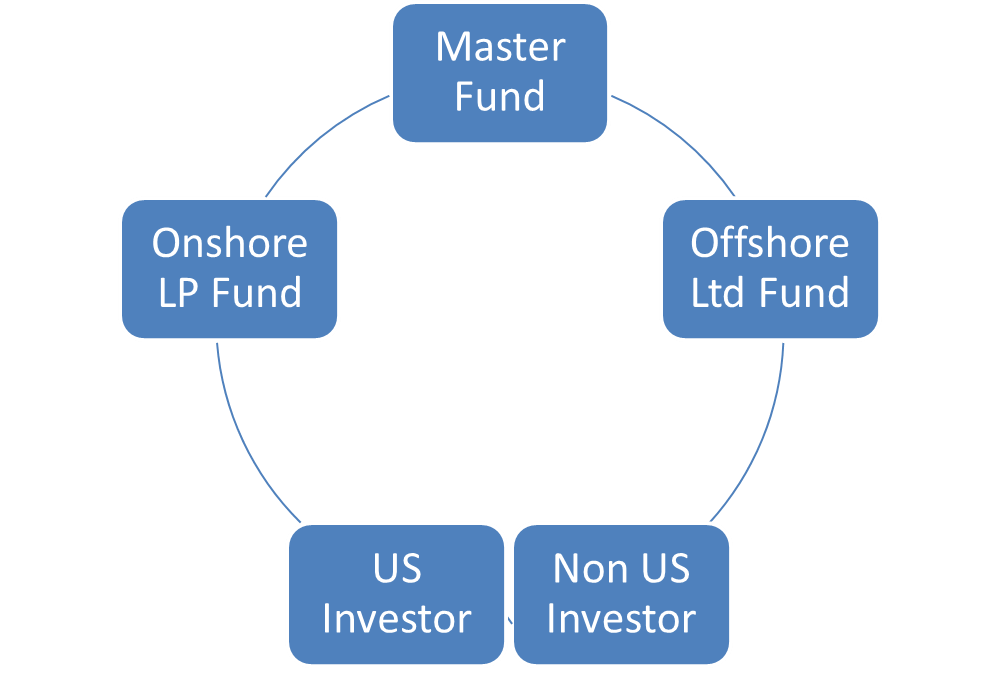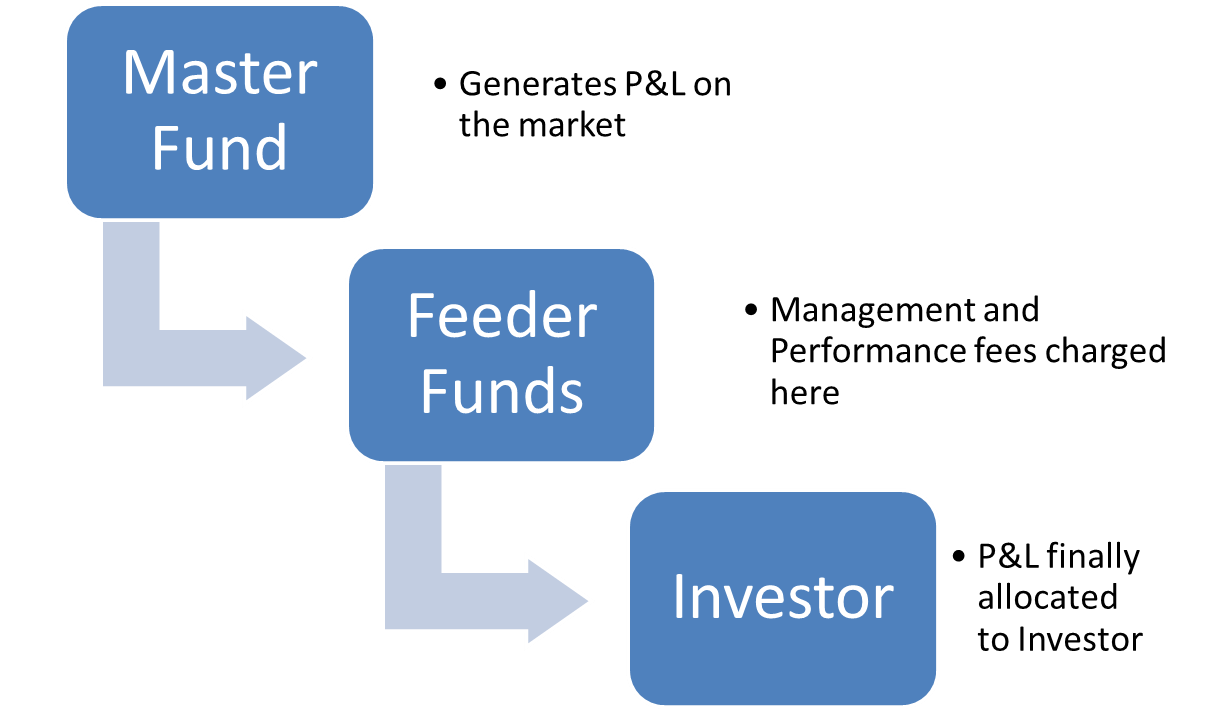Master Feeder Fund
Great start you've completed part 1 of 3
What is a Master Feeder Fund?
A master feeder fund is a type of hedge fund structure.
Investors place their money into feeder funds which then invests into a master fund. It is the master fund that actually invests in the market. All the market trading occurs at the master fund level.
The purpose of the feeder fund is to, funnily enough, 'feed' investor funds into the master fund and then receive the flow of P&L back which in is turn then feed to each investor at the feeder level.
Sound complicated? It can take a couple of reads for it sink in. Hopefully the following sections will help tie it all together so it starts making some sense.

A typical master feeder structure is comprised of:
- One master fund
- Two feeder funds as below:
- Onshore fund, Limited partnership organised in the U.S. LTD (for U.S. investors)
- Offshore corporation LP (for non-U.S. and U.S. tax-exempt investors)
Understanding Master Feeder Funds:
One way to understand Master Feeder funds is a method that works for a lot of things in life - follow the money! An investor starts at the feeder fund where they invest their money. This capital then flows from the feeder fund into the master fund. The master fund takes this cash and invests it on the markets. The P&L generated at the master fund is then allocated back to the two feeder funds. Finally the feeder funds allocate the P&L back down to the investor.

At this stage the capital has flowed full circle from investor to feeder to master back to feeder and finally back to investor.
Capital Flows
As mentioned earlier when understanding master feeder funds following the flow of money can help. Here we'll take a look at how the capital (investor's money) moves around the structure from one entity to the other.
Investing starts with the investor subscribing their cash into the feeder fund. The feeder fund then takes this capital along with any other subscriptions and invests them into the master fund.
For their investment in the feeder the investor will receive a shareholding in the case of the Offshore Ltd feeder or a percentage allocation in the case of the Onshore LP feeder.
It's good to note at this point that the feeder fund doesn't necessarily have to invest all of the capital received from the investor into the master. It can keep some capital back to pay expenses or even make direct feeder investments. In the majority of cases though the feeder will invest all its capital into the master fund and then withdraw capital when necessary to pay expenses.
When the respective feeder invests, to the master fund it appears as an investment from one of its investors. The master fund can then allocates the feeders a percentage allocation of the master funds P&L based on their holding in the master fund.
P&L Generation
Once the master fund has received in capital from the investor via the feeder funds it invests this cash on the markets. The portfolio is held at the master fund and any trading expenses, interest, dividends, buys, sells etc are accounted for here.
At the close of each reporting period a valuation of the master fund is completed. Based on this valuation the Fund Administrator will be able to calculate the amount of P&L generated by the master fund. As the feeder holding in the master fund is known the P&L can be allocated back down to the feeders based on their allocated ownership of the master fund.
Next up, how the P&L, which is generated at the master, flows back down to the feeders and then finally to the investor.

P&L Allocation
Now that the P&L generated at the master fund has flown down to the feeders the next and final step is to allocate it to the investors.
Each investor in the feeder will have either an amount of shares in the case of the offshore feeder or a percentage ownership in the case of the onshore feeder. These are used as the basis to calculate each investors pro-rata entitlement of P&L from the feeder total and ultimately the master fund.
You have now seen the full cycle of investor capital through the master feeder fund structure and the flow of P&L back down to the investor.
Essentially when a feeder fund invests in a master fund it is like buying shares in any other 'security'. However when a feeder fund invests in a security it cannot 'peer into' the underlying investment, it can for its investment in the master fund. This allows for the tax attributes e.g. dividends, income etc. to flow from the master to the feeder.
Why use a Master Feeder Fund?
A master-feeder fund structure is commonly used to manage funds raised from U.S. taxable investors and non-U.S. investors into one central vehicle - the master fund. Below are the two main reasons for using a master feeder fund structure:
- To save money. By creating a bigger pooled fund operational costs are reduced on a per investor basis.
- In order to effectively manage both U.S. taxable investors and non-U.S. investors in a single structure allowing the fund to cater for both sets of investors.
Advantages
- Multiple portfolios consolidated into one
- Reduced trading, transaction and operational costs
- Combined assets can be used to obtain better financing deals
- Flexible legal structure, additional feeder/master funds can be added
- General Partners performance fee will be able to maintain the underlying tax attributes of the onshore feeder
- Lessens administrative burden of accounting for multiple portfolios
- Reduces start-up costs
Disadvantages
- Tax accounting can become complicated
- May not offer advantages to all investors at all times
- Offshore fund subject to 30% withholding tax on U.S. dividends
Management Fees
Management fees are payments made by the investors in the feeder funds to the fund manager as compensation for managing the fund. They are typically charged at the feeder fund level only. The rate charged by the Investment Manager to the Investors is outlined in the Partnership Agreement.
Typically the Investment Manager will allow themselves the flexibility to charge different rates to different investors, classes or feeders. In some cases cash in withheld at the feeder level to pay the management fees. If there is not sufficient cash available to meet the payment then the feeder may choose to redeem capital from the master to cover the cost.
Performance Fees
Like management fees, performance fees are charged at the feeder level only. Once the P&L generated at the master fund has been allocated to each feeder performance fees can be calculated and allocated per partner. In the onshore feeder, this will take the form of a reallocation of profit from the limited partner to the general partner. In the offshore feeder, the performance fee is calculated by series.
Equalisation can be used to ensure that performance fees have been allocated to each investor in the offshore fund fairly. (Because allocating performance fees based on shares owned only it does not include the carried forward losses or timing of subscriptions.)
In order for fund managers to receive their fees in the most tax-beneficial manner the following is put in place:
- Onshore (LTD) feeders re-allocate their fees from the limited partners (the investors) to the general partners - the fund manager.
- Offshore (LP) feeders are corporations and must charge their fees to the shareholders. In the shareholder case fund managers take their performance fee in the form of deferred compensation.
Since reallocating income is still an acceptable way of compensating the manager in a tax-efficient way the shareholder feeder is set up to allow the reallocation of income back to the manager. This requires the following to be in place:
- The fund manager becomes a general partner of the master fund
- The master fund P&L flows to the feeder fund where the performance fee is calculated
- When the fund is closed for the period the fund manager takes it's fee
- definition of a master feeder fund
- how Capital & P&L flows through the structure
- reasons for using a master feeder fund
- advantages and disadvantages
- the treatment of performance and management fees
Good work, now test what you've learned below! Completed part 2 of 3
Well done. You've finished this lesson. Check out more lessons here
Subscribe to free lessons. Sign me up!
